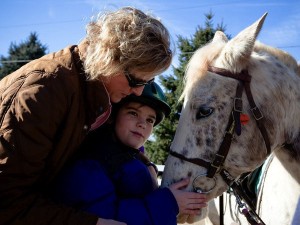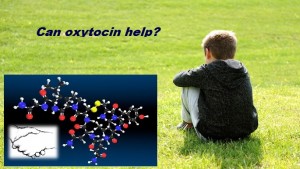Autism Spectrum Disorder is a group of complex disorders of brain development present from early childhood. The severity of symptoms varies greatly, but all people with autism have some symptoms in the areas of:
- Social Interactions and Relationships
- Verbal and Nonverbal Communication
- Limited Interests in Activities or Play
(WebMD)
What is AAT?
Animal-Assisted Therapy (AAT) is an intervention that uses animal interaction to help individuals with health problems or developmental disabilities recover and cope with their symptoms. The therapy is believed to have a variety of benefits, including personal and social development, increased self-esteem, improved mental health, better social skills and increased empathy and nurturing skills (Rovner, 2012).
How does AAT work?
The improvements in symptoms from AAT stem from the interaction with animals. Some forms of AAT like equine therapy involve taking care of the animals. In many cases therapists practice their usual techniques like applied behavioral analysis and speech therapy while using the animal to facilitate the therapy and increase the patient’s engagement and motivation. While the improvements are visible in the children’s interactions these benefits are difficult to quantify and prove because they are often unique to the individual. As a result the therapy is undervalued and more research is necessary to quantify the benefits of the therapy.
This podcast by NPR discusses the impact AAT has had on several different kinds of patients including Ryan, a 9 year old boy with autism.
Coleman, his speech pathologist, used to see Ryan in a more formal office setting but since he started horseback riding she says, “I get greater engagement, greater alertness, more language, more processing, all those things.” Ryan’s mother also claims to notice improvements not only in his speech but also in his ability to follow direction dissuading many safety concerns.
These benefits can be attributed to oxytocin, a naturally occurring hormone known for its social bonding and anti-stress effects. Odendaal and Meintjes (2003) found that interacting with animals increases people’s level of oxytocin. As a result animals help clinicians go under the radar of a child’s consciousness, because the child is much more at ease and willing.
Rebecca Johnson, a nurse who heads the Research Center for Human/Animal Interaction at the University of Missouri College of Veterinary Medicine explains that oxytocin not only helps us feel happy and trusting but also “has some powerful effects for us in the body’s ability to be in a state of readiness to heal, and also to grow new cells” (Rovner, 2012).
Oxytocin-Autism Connection
A new study, by researchers at Stanford University, investigated the role of oxytocin in autism. The investigators looked at blood levels of oxytocin in 79 children with ASD, 52 of their unaffected siblings and 62 children in families not affected by autism. Low, medium and high oxytocin blood levels occurred at similar rates in all three groups. These findings suggest that oxytocin deficiency does not cause autism (Parker et al, 2014).
However, they found that higher levels of oxytocin correlated with better social functioning. Children with the lowest levels of oxytocin had the most-severe social impairments while those with the highest levels had minimal social difficulties. Autism Speaks’ Chief Science Officer commented: “This definitely adds strength to the evidence that oxytocin could improve social behavior in those who have deficits in this area, including those who have autism” (Autism Speaks, 2014, August, 4).
Subsequently Autism Speaks decided to study if spraying oxytocin into the nose could increased social responsiveness in children with autism. However, when researchers gave mice pups oxytocin, their brains reduced sensitivity to the hormone and the mice grew up to be less social (Huang, 2014). They suggest that the inconsistent results might be because oxytocin delivered by nasal spray doesn’t reach all areas of the brain. Animal Assisted Therapy may be so successful because it increases natural secretion of oxytocin in all areas of the brain.
If you are more interested in the effects of oxytocin in the brain this Ted Talk further illustrates its role in empathy and how to naturally increase oxytocin levels.
References
Autism Speaks. (2015, February, 19). Can oxytocin treat autism? Autism Speaks Inc. Retrieved from: https://www.autismspeaks.org/science/science-news/can-oxytocin-treat-autism
Autism Speaks. (2015). What is Autism? Autism Speaks Inc. Retrieved from: https://www.autismspeaks.org/what-autism
Autism Speaks. (2014, August, 4). Study: Low Oxytocin Does Not Cause Autism But Can Worsen Social Disability. Autism Speaks Inc. Retrieved from: https://www.autismspeaks.org/science/science-news/study-low-oxytocin-does-not-cause-autism-can-worsen-social-disability
Huang, H. et al. (2014). Chronic and acute intranasal oxytocin produce divergent social effects in mice. Neuropsychopharmacology, 35. 1102-14.
Medical News Today. (2014, June, 12). Animal-assisted therapy: is it undervalued as an alternative treatment. Retrieved from: http://www.medicalnewstoday.com/articles/278173.php
Parker et al. (2014, Febuary, 4). Plasma oxytocin concentrations and OXTR polymorphisms predict social impairments in children with and without autism spectrum disorder. NPAS, 111. 12258–12263.
Rovner, J. (2012, March, 9). Pet therapy: how animals and humans heal each other. NPR. Retrieved from: http://www.npr.org/sections/health-shots/2012/03/09/146583986/pet-therapy-how-animals-and-humans-heal-each-other




Recent Comments